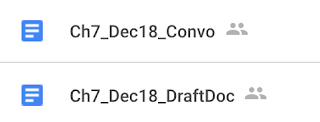In the summer of 2017, we created an "Indigenous Peoples History of the US Adaptation" folder in Google docs. Over time we came up with a method of working on each chapter.
We would create a folder for each chapter (Intro, Chapters 1-11, Conclusion). In each folder, we created a "Master" document where we pasted the chapter from the original manuscript that became Dunbar-Ortiz's book. We numbered every paragraph in the master copy. We then turned all the text in the master copy red and inserted some summary notes up top. Those notes helped us get a birds-eye view of a chapter's contents. Our goal was to submit adapted chapters that were no more than 3000 words. This is what the Master document looks like for chapter 8:
Every day that we worked (usually four or more hours, almost every day, for nearly three years), we started with a dated "Convo" file and a dated "Draft" file in the folder for the chapter we were working on that day. Here's what two documents in the folder for Chapter 7 look like:
If you opened a Convo doc, you would see that we began each one with a brief "yesterday, we did...." to get ourselves on the same page. That would be followed by a copy/paste of a numbered paragraph in red, and then we'd talk about that paragraph. Did we want to keep it, as is? Modify it? Keep the idea but rewrite the whole paragraph? Combine it with content from another paragraph?
If we decided to modify it, we'd dig in. I used purple font; Jean used blue. We worked one paragraph at a time. Sometimes it went quickly, other times it took, literally, days to get one paragraph done. Here's what the work on a few sentences in one paragraph looked like:
There, you see red font (which are from the Master copy of the original 2014 manuscript), you see blue (Jean) and purple (Debbie). We'd copy/paste these edits-in-progress chunks over and over as we revised, and then eventually, we'd turn the entire paragraph back into black font and see if we liked it. If we did, we would copy it into the "Draft" document for that day and start on a new paragraph. With each day's work, the dated Draft files grew in length. To some of you, that may seem redundant but a new draft document each day meant that if a file became corrupted for some reason (those of you who have lost work because of something like that know what a loss that can be!), we had a back-up copy with most of the work intact.
Interspersed between those colored font paragraphs is the conversations we had about the paragraph we were working on. We'd often say something like "Hang on, I'm gonna go see..." because we wanted to know more about some word, phrase, or name in a given paragraph. We'd do a deep dive into online sources, or books we had on our own shelves (or in e-books). If we thought there was something that would help with that paragraph, we'd paste the info in (or summarize it), and then incorporate that information into our revision.
Also interspersed between the colored font paragraphs was our emotional reactions to the content or to the additional research findings we did. History is violent. We were trying to be accurate but aware that young people would be reading the book.
Often, we wrestled with chronology. To help us keep things in chronological order, we made a lot of timelines. Some were small in scope and are inside a convo document. Others were larger. For those, we made Timeline documents. Those are working documents that are not actually in the book that came out in July.
By the time we got to the end of our work on a given chapter, we had paired Convo and Draft documents. Our last step was to do what we called "Top Down" reviews of our adapted chapter. These reviews gave us an opportunity to see if the chapter was coherent. If not, more edits! When we were satisfied with a chapter, we sent it to Beacon for editing, there.
As we worked we included notes to Beacon's editors that we wanted to insert a photograph or a textbox of information at that point in the chapter. Here's one, with the information we wanted to insert:
Photographs! We are aware that a lot of people use the sepia-toned photographs taken in the 1800s and early 1900s as if they're authentic images of Native people. That, however, is not the case! Photographers of those time periods often provided regalia and artifacts if the person being photographed didn't have what the photographer thought was appropriate. And, they removed items -- like clocks -- because those items did not fit with the photographer's concept of authenticity. The caption in this photograph in our adaptation addresses that problem. When we looked at this photograph, we wondered about the man in the foreground, lying on what looks like a buffalo robe. It struck us as a bit odd, so we did some research and found an article titled You Can't Believe Your Eyes: Inaccuracies in Photographs of North American Indians. Barthelmess's work is discussed in the article.
This "How did you" page is our effort to give readers a look into some of what we did as we adapted the book. Do you have additional questions? Let us know in a comment!






No comments:
Post a Comment